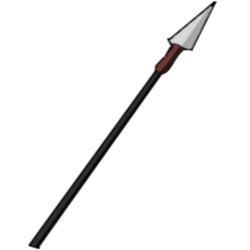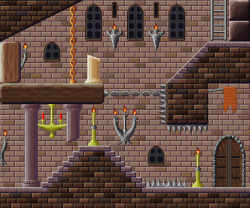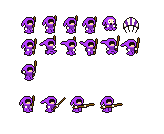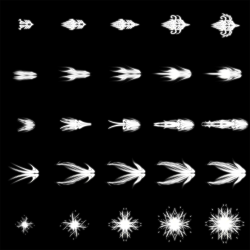Concept Devlog
(cover image courtesy of https://depositphotos.com/stock-photos/spear.html)
SPEAR is a fast-paced platformer where the goal is to get from point a to point b as fast as possible, avoiding hazards along the way. To do this, the player is given a spear on a rope to swing around and launch with, to help propel them to new heights and new speeds.
Genre
SPEAR will be a platformer primarily, as the main objective of the game is moving around the map, avoiding hazards. There is the possibility to add puzzle elements by introducing locked areas in the level and requiring the player to find keys or activate switches to progress.
Concept Creation Process
The main influence for this game is precision platformers, such as Celeste, and Give Up. These games both include a timer that tracks play time as the player progresses through their levels, for comparing with other people the amount of time they’ve spent in levels and the game overall. SPEAR wants to incorporate that into being front and centre of the game, where getting a low a time as possible rewards the player.
Give Up features very similar levels as the game progresses, with the room filling with hazards as the levels progress, eventually resetting for a new layout and repeating the process. SPEAR will encourage players to move quickly by creating hazards the longer they spend in an area.
Celeste is heavily focused on using its dash mechanic to move around the levels in, which is what SPEAR wants to do with its spear. Being able to swing across gaps or launch up higher to reach platforms you can’t normally jump to. Hollow Knight, while not a precision platformer, also features unique movement mechanics that can be used to get around levels, and sometimes access areas earlier than usual. This can be implemented in SPEAR by allowing creative uses of the spear mechanic to avoid puzzles or areas completely, decreasing the time of the player further.
Audience and Competitive Analysis
The primary audience for SPEAR will be people who are interested platforming, and ideally people interested in speedrunning. Whilst a direct audience for platformers is hard to define, it remains a prominent genre throughout gaming, both in 2D and 3D games. This is shown especially by the Mario series, which has kept a focus on platforming and drawn people of all types to it for 38 years.
Whilst speedrunning can be considered relatively niche, the community around games can be dedicated and really enjoy the games they learn to do it in, which can provide very useful feedback for the developer/s to improve the game.
Similar Titles:
Platformers have remained prominent in the gaming industry, notably in the Sonic and Mario series. Whilst not necessarily the oldest, these two franchises have remained two of the largest and best-selling titles. The simple nature of platforming, which is moving from platform to platform, allows it to appeal to everyone and anyone, and can be expanded upon further once that has been settled in.
The two series mentioned, whilst both platformers, play very differently to each other. The Sonic series emphasises speed and fluid movements through rewarding the player with score heavily biased towards fast completion of levels, whereas high points in Mario is achieved by “Comboing” enemy kills and generally being more precise, rather than mostly relying on pure speed.
Treatment
You’re at the bottom. They’re at the top. There’s something blocking your way, but that doesn’t matter. You just need to get up there. You can’t quite fly, but you’ve got the next best thing: A spear on a rope. There’s no way that’d be an issue though, right?
Gameplay
The core gameplay of SPEAR will focus on the platforming. Whilst hazards and puzzles may be included, these tend to be left wanting if navigating to and around them is unsavoury. The main element of gameplay to implement is the spear movement, as that’s what will really set the game aside from other platformers.
Whilst the game will introduce itself as a regular platformer, it will slowly introduce jumps that can only be made by launching yourself or swinging with the spear to cross wide gaps. This will allow the player to familiarise themselves with the controls before introducing them to parts that may seem unfair or punish them.
Being able to use the spear as a way to jump higher or swing across gaps will open the path to plenty of level variety, as well as the ability to add surfaces that the spear can’t stick into. This has been done in games such as Portal, where you can only use the portal gun on specific surfaces in the game.
Puzzles may mostly consist of switches opening doors or potentially targets to hit with the spear responding the same way, but ideally, they shouldn’t hinder the player’s ability to move through the level. Whilst it should be a bit more interesting than pure speed, it should be interesting to incorporate that speed into puzzle mechanics.

(Credit to WillM: https://opengameart.org/content/spear-5)
An example spear
The tilemaps used will attempt to give the game a medieval feel, like the player is ascending a tower, castle, or some other fortification.

(Credit to rubberduck: https://opengameart.org/content/pixel-art-castle-tileset)
An example tileset

(Credit to Disthron: https://opengameart.org/content/mr-necromancer-man-animated)
A potential look for the player
The types of enemies involved in SPEAR would mostly consist of simple magical bolts that would streak towards the player when they get within range, trying to hit where they’re moving to when activated and not track them any further. There is the potential to add types of enemy, such as ones that chase the player or readjust their aim. These could be potentially created and animated by Unity’s particle system, rather than using sprites for them.

(Credit to Cethiel: https://opengameart.org/content/pure-projectile-magic-effect)
A potential spritesheet for the enemy
The final potential addition would include a type of collectible to the levels, which could simply be spears. This gives the player incentive to explore the map for the potential reward of additional points. Alternatively, the pickups could simply exist within the particle system built in to Unity.
SPEAR
Swinging and Swoovin'
| Status | In development |
| Author | Helidara |
| Genre | Platformer |
More posts
- Devlog 6 - Updates and plansOct 17, 2021
- User GuideOct 17, 2021
- Game DocumentationOct 17, 2021
- User Interface and Polish - Devlog 5Oct 10, 2021
- Game TestingOct 07, 2021
- Graphics and Enemies - Devlog 4Oct 07, 2021
- Puzzles and Hazards – Devlog 3Sep 26, 2021
- Level Blocking - Devlog 2Sep 19, 2021
- Player Movement - Devlog 1Sep 12, 2021